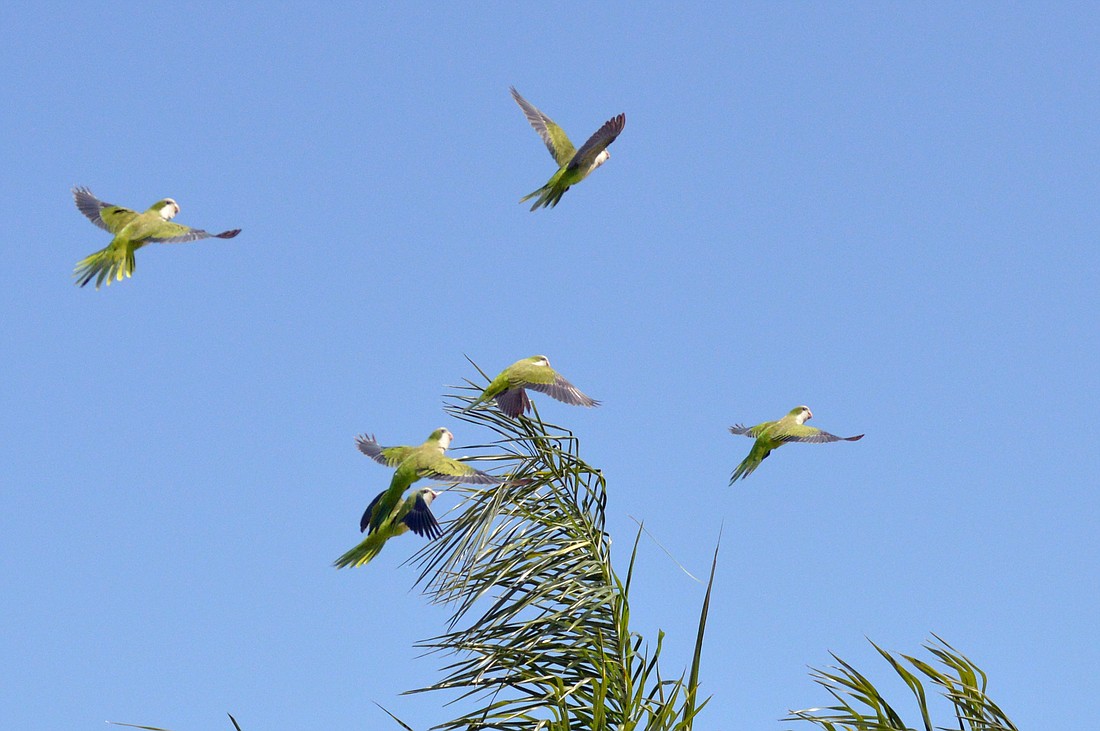- April 26, 2024
-
-
Loading

Loading

In a new take on the term “snowbirds,” a small family of monk parakeets have built a home on an electrical pole near the south bridge to Siesta Key.
“I just thought it was very unusual, it seemed like an odd place to build a nest,” said longtime visitor to the Key Sue Super.
She noticed the small green birds chirping from the top of a pole on Midnight Pass Road near Crescent Club, and snapped a picture to post on Facebook.
Typically, Super said she sees the small green birds in palm trees on the island, and they’re known to fly around the area in flocks. But experts say it’s not uncommon to see these and other birds nest on man-made objects on the island.
Although the parakeets — also known as quaker parrots — are among the coastal and tropical birds that have been calling Siesta Key home for years, they are not indigenous to the area.
Florida West Coast Avian Society President Rosemary Miller said the first monk parakeets on Siesta Key were likely pets that people let loose.
“They were successful in establishing colonies. That’s the genesis of their existence,” she said. “It’s a testament to their tenacity.”
Just a few blocks away, around the corner, ospreys have built a nest on top of the Stickney Point Bridge drawbridge signal.
“They’ll nest on anything flat,” retired Sarasota bird guide and member of the Audubon Society Rick Greenspun said. “Any place they can build a nest.”
Ospreys are aquatic predators, and typically live within a mile of water — making their position on top of the bridge a prime spot for feeding. But they’re also known to nest on private property elsewhere on the Key, like the monk parakeets.
Although the birds call Siesta Key home, their chosen nesting places on bridges and power poles can be problematic.
“[Monk parakeets] can build nests, which can be as big as cars, that damage FPL equipment, resulting in tens of thousands of customers losing power and millions of dollars in repair costs,” Florida Power & Light said in a statement.
The company removes nests as part of routine maintenance, or in response to service interruptions caused by the nests. The approach has been approved by the Florida Fish and Wildlife Conservation Commission, the statement said.
The Florida Department of Transportation has a similar approach to ospreys. If the nest material becomes a hazard to the public, a spokesperson said, it’s removed.
“We will not remove any active nests without a federal permit,” a statement from FDOT said. “If we find an active nest that is not a hazard to the public, we leave the nest alone until after the hatchlings leave and then remove the nest material.”
On Longboat Key, ospreys have a habit of nesting on drawbridge signals — so much so that FDOT installed equipment to deter the raptors from building nests there.
Even as these companies work to minimize the birds’ interaction with equipment, it’s not unusual to see people like Super stop beneath nests to photograph the birds on the Key.
“The people I am aware of appreciate seeing them,” Miller said. “But I don’t know. Not everyone’s a bird-lover.”